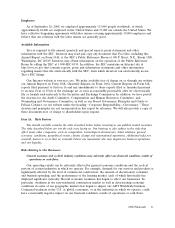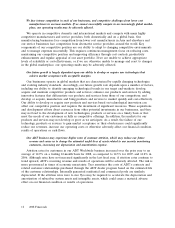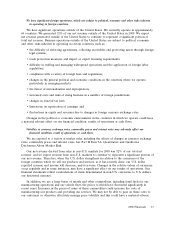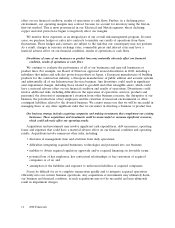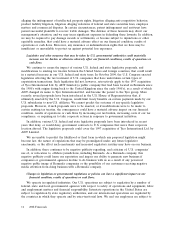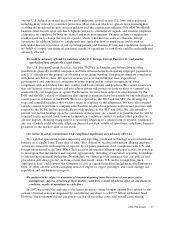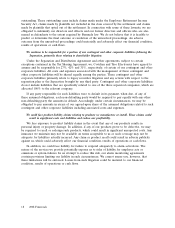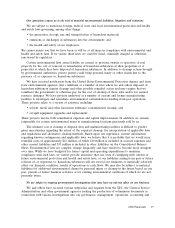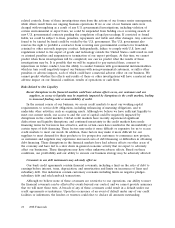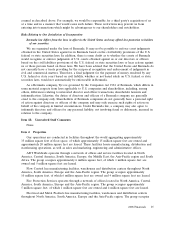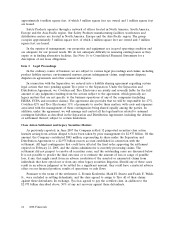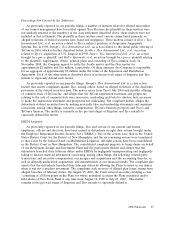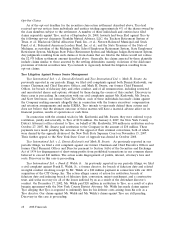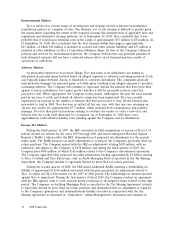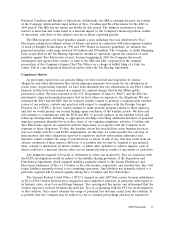ADT 2008 Annual Report Download - page 124
Download and view the complete annual report
Please find page 124 of the 2008 ADT annual report below. You can navigate through the pages in the report by either clicking on the pages listed below, or by using the keyword search tool below to find specific information within the annual report.thereunder to be immediately due and payable and terminate all commitments to extend further credit.
If the lenders or trustees accelerate the repayment of borrowings, we cannot provide assurance that we
will have sufficient assets to repay our credit facilities and our other indebtedness. Furthermore,
acceleration of any obligation under any of our material debt instruments will permit the holders of our
other material debt to accelerate their obligations, which could have a material adverse affect on our
financial condition. See ‘‘Liquidity and Capital Resources—Capitalization’’.
Material adverse legal judgments, fines, penalties or settlements could adversely affect our financial health
and prevent us from fulfilling our obligations under our outstanding indebtedness.
We estimate that our available cash, our cash flow from operations and amounts available to us
under our revolving lines of credit will be adequate to fund our operations and service our debt for the
foreseeable future. However, material adverse legal judgments, fines, penalties or settlements arising
from our pending investigations and litigation could require additional funding. If such developments
require us to obtain additional funding, we cannot provide assurance that we will be able to obtain the
additional funding that we need on commercially reasonable terms or at all, which could have a
material adverse effect on our financial condition, results of operations or cash flows.
Such an outcome could have important consequences to you. For example, it could:
• require us to dedicate a substantial portion of our cash flow from operations to payments on our
indebtedness, thereby reducing the availability of our cash flow to fund working capital, capital
expenditures, research and development efforts and other general corporate purposes, including
debt reduction or dividend payments;
• increase our vulnerability to general adverse economic and industry conditions;
• limit our flexibility in planning for, or reacting to, changes in our businesses and the industries in
which we operate;
• restrict our ability to introduce new technologies or exploit business opportunities;
• make it more difficult for us to satisfy our payment obligations with respect to our outstanding
indebtedness; and
• increase the difficulty and/or cost to us of refinancing our indebtedness.
Risks Relating to Tax Matters
We have disclosed a material weakness in our internal control over financial reporting relating to our
accounting for income taxes that could adversely affect our ability to report our financial condition,
results of operations or cash flows accurately and on a timely basis.
In connection with our assessment of internal control over financial reporting under Section 404 of
the Sarbanes-Oxley Act of 2002 for fiscal 2007, we identified a material weakness in our internal
control over financial reporting relating to our accounting for income taxes. For a discussion of our
internal control over financial reporting and a description of the identified material weakness, see
‘‘Management’s Report on Internal Control over Financial Reporting’’ under Item 9A, ‘‘Controls and
Procedures.’’
A material weakness is a deficiency, or a combination of deficiencies, in internal control over
financial reporting, such that there is a reasonable possibility that a material misstatement of the
Company’s annual or interim financial statements will not be prevented or detected on a timely basis.
During 2007, management’s procedures and testing identified errors that, although not material to the
consolidated financial statements, led management to conclude that control deficiencies exist related to
tax effecting consolidating entries, analysis and reconciliation of taxes receivable and taxes payable in
non-U.S. jurisdictions, certain aspects of deferred taxes, and procedures with respect to classification of
2008 Financials 21


